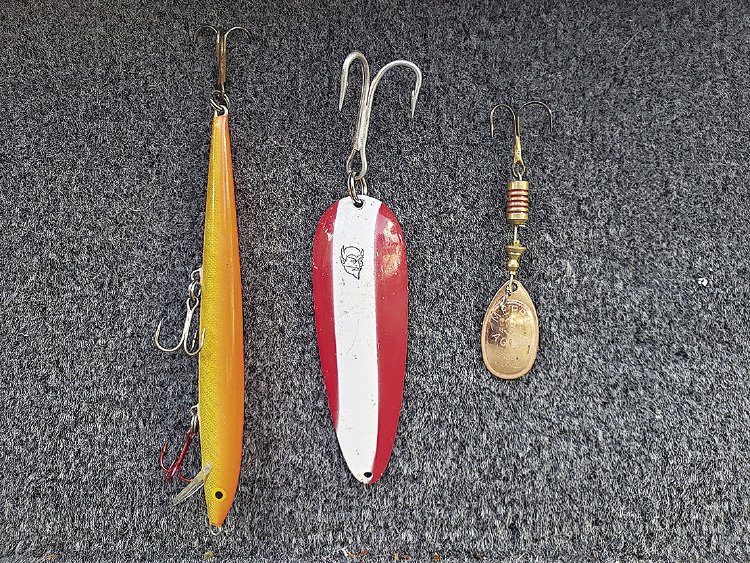Classic fishing lures are those that have stood the test of time, and survived the whims of the market. The list of lures that makes this list is remarkably short, considering the jaw dropping number of products that have been unleashed over the past 100 years. The great thing about classic fishing lures is they remain fish catchers to this day. These three lures should be a part of every angler’s collection.
Eppinger Dardevle
The red and white spoon is a standard bearer for northern pike anglers in Canada and the northern United States. Although many have made a red and white spoon, the Eppinger company made the original. The story goes that company founder Lou Eppinger spent a month alone in the Ontario wilderness, fishing and camping. He used a lure of his own design that looked like a spoon. The metal was thinner in the middle and thicker toward the edges. When he cast it into the shallows it would swing from side to side, flashing its colours.
By 1912, Lou turned his prototype into a finished lure, called the Osprey. It was deadly on pike. Six years later, Lou’s nephew Ed came to work for his uncle and they changed the name to Dardevle after the “Teufelhunden,” or “Devil Dogs,” the name given by the Germans to the 4th Marine Brigade. The allies then called the U.S. Marines “Dare Devils.” The red and white Dardevle became the standard bearer of the brand.
About 15 years ago, I had an opportunity to fish with Lou Eppinger’s great grandson in Saskatchewan. Not only did I get to hear stories of Lou and his fishing exploits, but also got to fish with a bunch of different Eppinger products. We caught pike, walleye and lakers on them all, but the red and white Dardevle was the rock star. It still rules.
Mepps Aglia Spinner
If you are a trout angler, and have fished with a “Mepps” spinner, the odds are it was an Aglia spinner. This is the classic “French style” trout spinner, with a simple, fail-safe design that can be cast or trolled, fished with a bait or without. The Mepps spinner was the very first lure I ever used to catch a brook trout, and it will always have a special place in my tackle box.
A French engineer named Andre Meulnart invented the original Mepps spinner back in 1938. Although he knew he had come up with a good bait, he probably didn’t realize his lure would be the basis of a huge boom in the fishing tackle industry. It would take a World War and an unusual series of events to do that. It would also take the vision of a man who realized the lure’s full potential. In 1951, Todd Sheldon discovered the Mepps spinner. Sheldon, who was the owner of a tackle store in Antigo, Wisc., was having a bad day on the water. He decided to try something different, and tied on a small Mepps spinner. The lure had been given to him by a WWII GI who had returned from Europe two years earlier. The story goes that within two hours, Sheldon had landed four trout weighing more than 12 pounds total. The rest is history.
Although the #3 Mepps Aglia is maybe the best trout catcher ever made, the lure is equally deadly on other species. The silver bladed Mepps Aglia is especially good at catching smallmouth bass, and is one of the secret lures that tournament bass anglers don’t talk about. When bass or trout are busting minnows on the surface, the spinner is unbelievably effective. A must have for steelhead as well.
Rapala Floating Minnow
The Rapala name needs no introduction. There are at least a dozen classic lures that bear that name. But it all began with the original floating minnow. This is a true classic that remains a ringer for all species.
The birth of the Rapala minnow is the thing of legend. It dates back to the 1930s when Lauri Rapala made the observation that big fish eat little fish, especially those acting erratically. Rapala fished the waters of Finland’s Lake Paijanne, and saw how large predators would always focus on an injured minnow. He decided it was time to make something that would mimic that injured wobble. In 1936, using a shoemaker’s knife, some sandpaper, and his imagination, Rapala created his first prototype lure from cork. To mimic the flash of a baitfish, he used tinfoil from a chocolate bar on the lure’s outer surface. Melted photographic negatives sealed the plug. The most important thing, however, was how well the whittled cork plug approximated the action of a minnow. Legend has it that Lauri Rapala sometimes caught 600 pounds of fish a day with his new, home-made lure. The lure’s reputation grew—crossed into North America—and the rest is history. Lauri Rapala’s simple original floating minnow design remains a fish killer to this day.
Like a lot of Canadian kids who were nuts about angling, I grew up seeing Rapala minnows in the tackle boxes of anglers. My hometown of Thunder Bay also has more Finns per capita than anywhere else outside of Helsinki, and having Rapala minnows on the line was a source of “old country” pride for many anglers of the Finnish extraction. It was not hard to find them for sale in the Lakehead, even in the early 1970s. The first walleye I ever caught on a plug hit a silver floating Rapala weighted with a rubber core sinker and trolled along bottom. I can also remember casting an oversized Rapala floating minnow for pike on Thunder Bay’s waterfront. To this day, the floating minnow is a deadly presentation, and accounts for everything from salmon on downriggers to bass in the lily pads to Lake Superior coaster brook trout up close to shore.
Some things just never get old. These three classic lures remain ageless and timeless.




